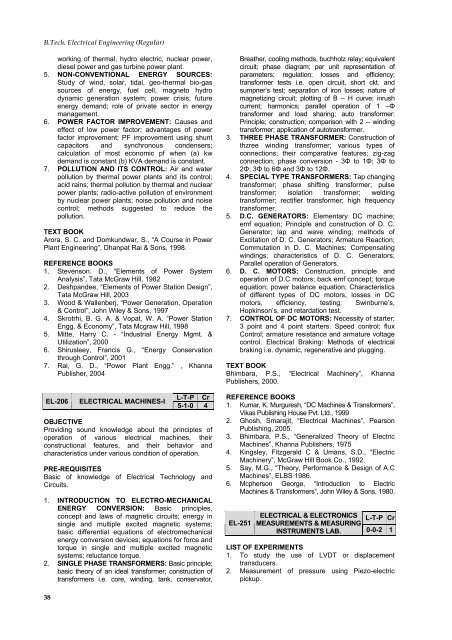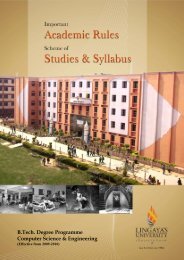B.<strong>Tech</strong>. <strong>Electrical</strong> <strong>Engineering</strong> (Regular)working of thermal, hydro electric, nuclear power,diesel power and gas turbine power plant.5. NON-CONVENTIONAL ENERGY SOURCES:Study of wind, solar, tidal, geo-thermal bio-gassources of energy, fuel cell, magneto hydrodynamic generation system; power crisis; futureenergy demand; role of private sector in energymanagement.6. POWER FACTOR IMPROVEMENT: Causes andeffect of low power factor; advantages of powerfactor improvement; PF improvement using shuntcapacitors and synchronous condensers;calculation of most economic pf when (a) kwdemand is constant (b) KVA demand is constant.7. POLLUTION AND ITS CONTROL: Air and waterpollution by thermal power plants and its control;acid rains; thermal pollution by thermal and nuclearpower plants; radio-active pollution of environmentby nuclear power plants; noise pollution and noisecontrol; methods suggested to reduce thepollution.TEXT BOOKArora, S. C. and Domkundwar, S., “A Course in PowerPlant <strong>Engineering</strong>”, Dhanpat Rai & Sons, 1998.REFERENCE BOOKS1. Stevenson. D., “Elements of Power SystemAnalysis”, Tata McGraw Hill, 19822. Deshpandee, “Elements of Power Station Design”,Tata McGraw Hill, 20033. Wood & Wallenberj, “Power Generation, Operation& Control”, John Wiley & Sons, 19974. Skrotrhi, B. G. A. & Vopat, W. A. “Power StationEngg. & Economy”, Tata Mcgraw Hill, 19985. Mitte, Harry C. - “Industrial Energy Mgmt. &Utilization”, 20006. Shirusleey, Francis G., “Energy Conservationthrough Control”, 20017. Rai, G. D., “Power Plant Engg.” , KhannaPublisher, 2004EL-206ELECTRICAL MACHINES-IL-T-P Cr5-1-0 4OBJECTIVEProviding sound knowledge about the principles ofoperation of various electrical machines, theirconstructional features, and their behavior andcharacteristics under various condition of operation.PRE-REQUISITESBasic of knowledge of <strong>Electrical</strong> <strong>Tech</strong>nology andCircuits.1. INTRODUCTION TO ELECTRO-MECHANICALENERGY CONVERSION: Basic principles,concept and laws of magnetic circuits; energy insingle and multiple excited magnetic systems;basic differential equations of electromechanicalenergy conversion devices; equations for force andtorque in single and multiple excited magneticsystems; reluctance torque.2. SINGLE PHASE TRANSFORMERS: Basic principle;basic theory of an ideal transformer; construction oftransformers i.e. core, winding, tank, conservator,Breather, cooling methods, buchholz relay; equivalentcircuit; phase diagram; per unit representation ofparameters; regulation; losses and efficiency;transformer tests i.e. open circuit, short ckt. andsumpner’s test; separation of iron losses; nature ofmagnetizing circuit; plotting of B – H curve; inrushcurrent; harmonics; parallel operation of 1 –Φtransformer and load sharing; auto transformer:Principle; construction; comparison with 2 – windingtransformer; application of autotransformer.3. THREE PHASE TRANSFORMER: Construction ofthzree winding transformer; various types ofconnections; their comparative features; zig-zagconnection; phase conversion - 3Φ to 1Φ; 3Φ to2Φ; 3Φ to 6Φ and 3Φ to 12Φ.4. SPECIAL TYPE TRANSFORMERS: Tap changingtransformer; phase shifting transformer; pulsetransformer; isolation transformer; weldingtransformer; rectifier transformer; high frequencytransformer.5. D.C. GENERATORS: Elementary DC machine;emf equation; Principle and construction of D. C.Generator; lap and wave winding; methods ofExcitation of D. C. Generators; Armature Reaction;Commutation in D. C. Machines; Compensatingwindings; characteristics of D. C. Generators;Parallel operation of Generators.6. D. C. MOTORS: Construction, principle andoperation of D.C motors; back emf concept; torqueequation; power balance equation; Characteristicsof different types of DC motors, losses in DCmotors, efficiency, testing: Swinburne’s,Hopkinson’s, and retardation test.7. CONTROL OF DC MOTORS: Necessity of starter;3 point and 4 point starters. Speed control; fluxControl; armature resistance and armature voltagecontrol. <strong>Electrical</strong> Braking: Methods of electricalbraking i.e. dynamic, regenerative and plugging.TEXT BOOKBhimbara, P.S., “<strong>Electrical</strong> Machinery”, KhannaPublishers, 2000.REFERENCE BOOKS1. Kumar, K. Murguresh, “DC Machines & Transformers”,Vikas Publishing House Pvt. Ltd., 19992. Ghosh, Smarajit, “<strong>Electrical</strong> Machines”, PearsonPublishing, 2005.3. Bhimbara, P.S., “Generalized Theory of ElectricMachines”, Khanna Publishers, 19754. Kingsley, Fitzgerald C & Umans, S.D., “ElectricMachinery”, McGraw Hill Book Co., 1992.5. Say, M.G., “Theory, Performance & Design of A.CMachines”, ELBS 1986.6. Mcpherson George, “Introduction to ElectricMachines & Transformers”, John Wiley & Sons, 1980.ELECTRICAL & ELECTRONICS L-T-P CrEL-251 MEASUREMENTS & MEASURINGINSTRUMENTS LAB. 0-0-2 1LIST OF EXPERIMENTS1. To study the use of LVDT or displacementtransducers.2. Measurement of pressure using Piezo-electricpickup.38
Lingaya’s University, Faridabad3. To calibrate an energy meter with the help of astandard wattmeter and a stop watch.4. To measure power and p.f. by 3-ammeter and 3-voltmeter method.5. To measure power and p.f in 3-phase circuit by 2-wattmeter method.6. To measure capacitance by De Sauty's bridge.7. To measure inductance by Maxwell's bridge.8. To measure frequency by Wien's bridge.9. To measure the power with the help of C.T and P.T.10. Measurement of distance by capacitive pick-up.11. Measurement of temperature using thermo-couple.12. To measure low resistance by Kelvin's double bridge.13. To measure high resistance by loss of charge method.REFERENCE BOOKS1. Gupta, J.B, “<strong>Electrical</strong>/Electronic Measurement andInstrumentations”, Kataria & Sons, Year Jan 2007-082. Cooper, W. D. & Helfriek, A. D, “<strong>Electrical</strong>Measurement”, Prentice Hall of India, 19993. Doeblin, E. O, ‘’ Measuring System’’, Tata McGrawHill, 2000EL-253NETWORK ANALYSIS & L-T-P CrSYNTHESIS LAB 0-0-2 1LIST OF EXPERIMENTS1. Transient response of RC circuit.2. Transient response of RL circuit.3. To find the resonance frequency, Band width ofRLC series circuit.4. To calculate and verify “Z" parameters of a twoport network.5. To calculate and verify "Y" parameters of a twoport network.6. To determine equivalent parameter of parallelconnections of two port network.7. To plot the frequency response of low pass filterand determine half-power frequency.8. To plot the frequency response of high pass filtersand determine the half-power frequency.9. To plot the frequency response of band-pass filtersand determines the band-width.10. To calculate and verify "ABCD" parameters of atwo port network.11. To synthesize a network of a given network functionand verify its response.12. Introduction of P-SpiceREFERENCE BOOKS1. Kuh, Dasoer,“Basic circuit theory”,Tata McGrawHill, 2001.2. Soni &Gupta,“A Course in <strong>Electrical</strong> CircuitAnalysis”,Dhanpat Rai Publication, 2008.3. Mithal,G.K,“Circuit Analysis”, Khanna Publication,2002.ANALOG ELECTRONICS & AE L-T-P CrEL-254CIRCUITS LAB. 0-0-2 1LIST OF EXPERIMENTS:1. Study of half wave and full wave rectifiers.2. Study of power supply filters.3. Study of diode as clipper and clamper.4. Study of Zener diode as a voltage regulator.5. Study of CE amplifier for voltage, current andPower gains and input, output impedances.6. Study of CC amplifier as a buffer.7. To study the frequency response of RC coupledamplifier.8. Study of 3-terminal IC regulator.9. Study of transistor as a constant current source inCE configuration.10. Study of FET common source amplifier.11. Study of FET common drain amplifier.12. Graphical determination of small signal hybridparameters of bipolar junction transistor.13. Study and design of a D.C. voltage doubler.REFERENCE BOOKS1. Mehta, V. K., “Principles of Electronics”, S. Chandand Co.,19962. Schilling, Donald L & Belove, Charles, “ElectronicCircuits”, Tata McGraw Hill, 20003. Galkwad, “Operational Amplifiers”, 1993.EL-256ELECTRICAL MACHINES-I L-T-P CrLAB. 0-0-2 1LIST OF EXPERIMENTS1. To find turns ratio and polarity of a 1-phasetransformer.2. To perform open and short circuit tests on a 1-phase transformer.3. To perform Sumpner's Back to back test on 1-phase transformers.4. Parallel operation of two 1-phase transformers.5. To convert three phase to 2-phase by Scottconnection.6. To perform load test on DC shunt generator.7. Speed control of DC shunt motor.8. Swinburne’s test of DC shunts motor.9. Hopkinson’s test of DC shunt M/Cs.10. Ward Leonard method of speed control.11 To plot o.c.c. Of D.C. Shunt generator12 To perform load test on DC shunt Motor.REFERENCE BOOKS1. Kumar, K. Murguresh, “DC Machines &Transformers”, Vikas Publishing House Pvt. Ltd.,19992. Ghosh, Smarajit, “<strong>Electrical</strong> Machines”, PearsonPublishing, 2005.3. Bhimbara, P.S., “Generalized Theory of ElectricMachines”, Khanna Publishers, 1975EL-301CONTROL SYSTEMSL-T-P Cr5-1-0 4OBJECTIVEProviding sound knowledge about the various controlsystem techniques required for the operation and accuratecontrols of Industrial processes and other strategies forcomplicated processes and efficient control.PRE-REQUISITESKnowledge of Mathematics and <strong>Electrical</strong> <strong>Engineering</strong>1. INTRODUCTION TO CONTROL PROBLEM:Industrial control examples; Transfer function39
- Page 1 and 2: B.Tech. Degree ProgrammeElectrical
- Page 5 and 6: Lingaya’s University, FaridabadAB
- Page 7 and 8: IMPORTANT ACADEMIC RULESB.Tech. Deg
- Page 9 and 10: Lingaya’s University, Faridabadac
- Page 11 and 12: Lingaya’s University, FaridabadSe
- Page 13 and 14: Lingaya’s University, FaridabadIn
- Page 15 and 16: CATEGORY-WISE LIST OF COURSESLingay
- Page 17 and 18: Lingaya’s University, FaridabadSU
- Page 19 and 20: Lingaya’s University, FaridabadSc
- Page 22 and 23: B.Tech. Electrical Engineering (Reg
- Page 24 and 25: B.Tech. Electrical Engineering (Reg
- Page 26 and 27: B.Tech. Electrical Engineering (Reg
- Page 28 and 29: B.Tech. Electrical Engineering (Reg
- Page 30 and 31: B.Tech. Electrical Engineering (Reg
- Page 32 and 33: B.Tech. Electrical Engineering (Reg
- Page 34 and 35: B.Tech. Electrical Engineering (Reg
- Page 36 and 37: B.Tech. Electrical Engineering (Reg
- Page 38 and 39: B.Tech. Electrical Engineering (Reg
- Page 40 and 41: B.Tech. Electrical Engineering (Reg
- Page 44 and 45: B.Tech. Electrical Engineering (Reg
- Page 46 and 47: B.Tech. Electrical Engineering (Reg
- Page 48 and 49: B.Tech. Electrical Engineering (Reg
- Page 50 and 51: B.Tech. Electrical Engineering (Reg
- Page 52 and 53: B.Tech. Electrical Engineering (Reg
- Page 54 and 55: B.Tech. Electrical Engineering (Reg
- Page 56 and 57: B.Tech. Electrical Engineering (Reg
- Page 58 and 59: B.Tech. Electrical Engineering (Reg
- Page 60 and 61: B.Tech. Electrical Engineering (Reg
- Page 62 and 63: B.Tech. Electrical Engineering (Reg
- Page 64 and 65: B.Tech. Electrical Engineering (Reg
- Page 66 and 67: B.Tech. Electrical Engineering (Reg
- Page 68 and 69: B.Tech. Electrical Engineering (Reg
- Page 71 and 72: OPEN ELECTIVELingaya’s University
- Page 73 and 74: Lingaya’s University, Faridabadch
- Page 75 and 76: Lingaya’s University, Faridabad4
- Page 77 and 78: Lingaya’s University, Faridabad6.
- Page 79 and 80: Lingaya’s University, FaridabadEL
- Page 81 and 82: Lingaya’s University, Faridabad5
- Page 83 and 84: Lingaya’s University, Faridabador
- Page 85 and 86: Lingaya’s University, Faridabad4.
- Page 87: Lingaya’s University, Faridabad83
















